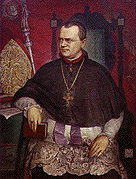 Featured
Scientist: Gregor Mendel
Featured
Scientist: Gregor Mendelsource of image
Notes for Evolution - The Triumph of an Idea - Chapter 4
Click link to return to Biology
409 Schedule
or back to Chapter 3 or ahead to Chapter
5
General guide on these review questions here
Chapter 4 - Witnessing Change - Genes, Natural Selection, and Evolution in Action
PBS Website Link
Introduction
 Featured
Scientist: Gregor Mendel
Featured
Scientist: Gregor Mendel
source
of image
Links: 1 -
2 - 3
- 4
For much more extensive coverage of Mendel and genetic inheritance see Understanding
Evolution Ch. 3.
I. Introduction
RQ Ev-4.1: In what ways (if any) did not knowing about how traits are inherited limit Darwin in what he could conclude about his proposed mechanism of natural selection?
II. Heredity's Monk
Key Terms: deoxyribonucleic acid
RQ Ev-4.2: In what ways (if any) did not knowing about DNA and how proteins are encoded limit Mendel in what he could conclude about his proposed mechanism of inheritance?
RQ Ev-4.3: Briefly summarize, at a 9th-grade level, how information in "the genes" becomes expressed in "the phenotype."
III. Rewriting Life's Cookbook
For much more extensive coverage of mutations see Understanding Evolution Ch. 4.
RQ Ev-4.4: Briefly describe the role mutations play in evolution, compared with other factors such as sexual recombination and natural selection. When a mutation occurs, has evolution taken place?
RQ Ev-4.5: In the example in Zimmer, how could a cross between two smooth hybrid pea plants (heterozygotes for smooth and wrinkled alleles) end up with all four progeny being wrinkled phenotypes?
IV. The Modern Synthesis
For much more extensive coverage of Dobzhansky's contributions see Understanding Evolution Ch. 6.
Featured Organism: Drosophila pseudoobscura
Links: 1 - 2 - 3 - 4Drosophila spp. (other species in same genus)
Links: 1 - 2 - 3 - 4 - 5 - 6 - 7 - 8 - 9
Featured Scientist: Theodosius Dobzhansky
Source of image
RQ Ev-4.6: How did Dobzhansky's studies reveal a previously unknown wealth of natural variation in flies and other organisms, and what were the implications of his discoveries?
RQ Ev-4.7: How did Dobzhansky influence ornithologist, Ernst Mayr, and mammalian paleontologist, George Simpson, in helping them formulate hypotheses of how speciation might normally occur?
V. Bird Beaks and Guppy Lifetimes
Featured Scientist: David Reznick
Source of image
For much more extensive coverage of the Galápagos finches see Understanding Evolution Ch. 12.
RQ Ev-4.8: Compare and contrast the studies on guppies by David Reznick and the studies on Galápagos finches by Peter and Rosemary Grant.
VI. How Species are Made
RQ Ev-4.9: Use the evolutionary tree on p. 89 of Zimmer to support the claim that the Galápagos finches had a single common ancestor, which then radiated into species with different ecological roles. Consider how the tree would have looked, for example, if multiple species colonized the islands, and then perhaps each radiated into different species that retained their ancestor's ecology.
RQ Ev-4.10: Why are the speciation events leading to hundreds of cichlid species in East Africa's Lake Victoria and other nearby "rift" lakes considered to be a rather spectacular example of "adaptive radiation"?
VII. Fighting Colds with Natural Selection
RQ Ev-4.11: Explain how our immune system has a sort of built-in natural selection mechanism for fighting colds and other diseases?:
VIII. Evolution In Silico
RQ Ev-4.12: Compare and contrast the approach used in the field of evolutionary computing with real-life evolution in natural populations of organisms.
Click link to return to Biology 409
Schedule
or back to Chapter 3 or ahead to Chapter
5
This page created 2/3/03 © D.J. Eernisse, Last Modified 7/4/03, Links Last Completely Checked 2/3/03